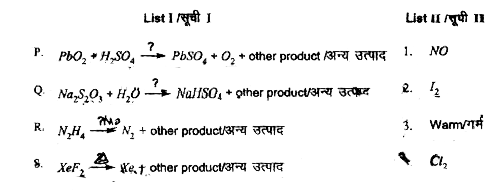दिए हुए उपात्त का प्रयोग कर, C2H2 में एक C≡C बन्ध की बहुआबन्ध ऊर्जा (multiple bond energy, kJmol−1) का परिकलन कीजिए। वह ऊर्जा निम्न है (C-H बन्ध की बन्धन ऊर्जा 350kJmol−1 लें)
(2C(s)+H2(g)→C2H2(g),ΔH=225kJmol−1),(2C(s)→2C(g),ΔH=1410kJ mol−1),(H2(g)→2H(g),ΔH=330kJmol−1)
1165
837
865
815
Step by step video & image solution for दिए हुए उपात्त का प्रयोग कर, C_(2)H_(2) में एक C-=C बन्ध की बहुआबन्ध ऊर्जा (multiple bond energy, kJ "mol"^(-1)) का परिकलन कीजिए। वह ऊर्जा निम्न है (C-H बन्ध की बन्धन ऊर्जा 350 kJ "mol"^(-1) लें) {:(2C(s) + H_(2)(g) to C_(2)H_(2)(g), DeltaH = 225 kJ "mol"^(-1)), (2C(s) to 2C(g), DeltaH = 1410 "kJ mol"^(-1)), (H_(2)(g) to 2H(g), DeltaH = 330 kJ "mol"^(-1)) by Chemistry experts to help you in doubts & scoring excellent marks in Class 12 exams.
Updated on:21/07/2023Topper's Solved these Questions
- JEE ADVANCED पेपर - 2 (2012)BOOK - JEE Main & Advanced (Hindi Medium)CHAPTER - JEE ADVANCED पेपर - 2 (2012)EXERCISE - भाग - II : रसायन विज्ञान खंड -II: एकल सही उत्तर प्रकार
6 Videos
- JEE ADVANCED पेपर - 2 (2012)BOOK - JEE Main & Advanced (Hindi Medium)CHAPTER - JEE ADVANCED पेपर - 2 (2012)EXERCISE - भाग - II : रसायन विज्ञान खंड - III : बहुल सही उत्तर प्रकार
6 Videos
- JEE ADVANCED पेपर - 1 (2021)BOOK - JEE Main & Advanced (Hindi Medium)CHAPTER - JEE ADVANCED पेपर - 1 (2021)EXERCISE - CHEMISTRY (खंड- 4)
3 Videos
- JEE ADVANCED पेपर - 2 (2013)BOOK - JEE Main & Advanced (Hindi Medium)CHAPTER - JEE ADVANCED पेपर - 2 (2013)EXERCISE - PART II : CHEMISTRY (खण्ड -3 ) (सुमेलन सूची प्रकार)
4 Videos
Similar Questions
दिया हुआ विद्युत रासायनिक सेल एक सांद्रता सेल है। M∣M2 (एक अल्पविलेय लवण का संतृप्त विलयन, MX2)∣M2+(0.001mol dm−3∣M) इसका सेलविभव (emf) दोनों इलैक्ट्रोडों पर M2+ आयन की सांद्रता के अंतर पर निर्भर है। इस सेल का emf 298 K ताप पर 0.059 V है।
दिये गए सांद्रता सेल के उपात्त (data) के आधार पर MX2 के विलेयता गुणनफल (Ksp:mol3dm−9) का 298 K पर मान । क्या है ?
View Solutionग्रेफाइट (graphite) और हीरे (diamond) के संदर्भ में कौन प्रकथन सही है/हैं ?
View SolutionBr2 तथा UV प्रकाश के उपयोग 1-मेथिलसाइक्लोहेक्स-1-ईन के मोनोब्रोमीनीकरण पर बनने वाले संभव समावयवियों (त्रिविम समावयव सहित) की अधिकतम संख्या ______ हो सकती है।
View Solutionसूची I में लिखित असंतुलित अभिक्रियाओं में अप्रदर्शित अभिकर्मक/अवस्थाएँ सूची II में दी गई हैं । सूची I को सूची II से सुमेलित कीजिए तथा सूचियों के नीचे दिए गये कोड का प्रयोग करके सही उत्तर चुनिये :

View SolutionCalculate the resonance enegry of toulene (use Kekule structure form the following data
C7H8(l)+9O2(g)→7CO2(g)+4H2O(l)+ΔH,ΔHΘ=−3910kJmol−1
C7H8(l)→C7H8(g),ΔHΘ=38.1kJmol−1
ΔfHΘ(water)=−285.8kJmol−1
ΔfHΘ[CO2(g)]=−393.5kJmol−1
Heat of atomisaiton of H2(g)=436.0kJmol−1
Heat of sulimation of C(g)=715.0kJmol−1
Bond energies of C−H,C−C, and C=C are 413.0,345.6, and 610.0kJmol−1.
View SolutionUsing the data provided, calculate the multiple bond energy (kJmol−1) of a C≡C bond in C2H2. That energy is ( take the bond energy of a X−H bond as 350kJmol−1).
2C(s)+H2(g)→C2H2(g),Δ=225kJmol−1
2C(g)→2Cg),ΔH=1410kJmol−1
H2(g)→2H(g),ΔH=330kJmol−1
View SolutionThe average O−H Bond energy in H2O with the help of following data :
(P) H2O(l)→H2O(g), ΔH=+40.6kJmol−1
(Q) 2H(g)→H2(g), ΔH=−435.0kJmol−1
(R ) O2(g)→2O(g), ΔH=+489.6kJmol−1
(S) 2H2(g)+O2(g)→2H2O(l), ΔH=−571.6kJmol−1
View SolutionGiven C_(2)H_(2)(g)+H_(2)(g)rarrC_(2)H_(4)(g): DeltaH^(@)=-175 " kJ mol"^(-1) DeltaH_(f(C_(2)H_(4),g))^(@)=50 " kJ mol"^(-1), DeltaH_(f(H_(2)O,l))^(@)=-280 " kJ mol"^(-1), DeltaH_(f(CO_(2)g))^(@)=-390 " kJ mol"^(-1) If DeltaH^(@) is enthalpy of combustion (in kJ "mol"^(-1) ) of C_(2)H_(2) (g), then calculate the value of |(DeltaH^(@))/(257)|
View SolutionUsing the data provided, calculate the multiple bond energy (kJ mol^(-1)) of a C-=C bond in C_(2)H_(2) . That energy is (take the bond energy of a C-H bond as 350 kJ mol^(-1) ) 2C(s)+H_(2)(g)rarrC_(2)H_(2)(g)" "DeltaH=225 kJ mol^(-1) 2C(s)rarr2C(g)" "DeltaH=1410kJ mol^(-1) H_(2)(g)rarr2H(g)" "DeltaH=330kJ mol^(-1)
View SolutionUsing the data provided, calculate the bond energy ( kJ mol^(-1)) of a C-=C bond in C_(2)H_(2) . That eneergy is ( take the bond energy ofC-H bond as350 kJ mol^(-1)) 2C(s) + H_(2)(g) rarr C_(2)H_(2)(g)" " DeltaH = 225 kJ mol^(-1) 2C(s) rarr 2C(g) " " DeltaH = 1410 kJ mol^(-1) H_(2)(g) rarr 2H(g)" " DeltaH = 330 kJ mol^(-1)
View SolutionUsing the data provided, calculate the mutliple bond energy (kJ mol−1) of a C≡C bond in C2H2. That energy is (take the bond energy of a C-H bond as 350 kJ mol−1)
2C(s)+H2(g)→HC≡CH(g),ΔH=225kJmol−1
2C(s)→2C(g),Δ=1410kJ mol−1
H2(g)→2H(g),ΔH=330kJ mol−1
View SolutionUsing the data provided, calculate the multiple bond energy (kJ mol−1 ) of a C≡C bond in C2H2 . That energy is (take the bond energy of a C- H bond as 350 kJ mol−1)
2C(s)+H2(g)→C2H2(g)ΔH=225kJmol−1
2C(s)→2C(g) ΔH=1410kJmol−1
H2(g)→2H(g) ΔH=330kJmol−1
View SolutionUsing the data provided, calculate the multiple bond energy ( kJ "mol"^(-1) ) of a C equiv C bond in C_(2)H_(2) .That energy is (take the bond enrgy of a C-H bond as 350 kJ "mol"^(-1) ): 2C(s) + H_(2)(g) to C_(2)H_(2)(g), DeltaH = 225 kJ "mol"^(-1) 2C(s) to 2C(g), DeltaH = 1410 kJ "mol"^(-1) H_(2)(g) to 2H(g), DeltaH = 330 kJ "mol"^(-1)
View Solutionदिए हुए आँकड़ों का प्रयोग कर, C2H2 में एक C≡C बंध की बहुआबन्ध ऊर्जा (multiple bond energy kJ mol−1) का परिकलन कीजिए। वह ऊर्जा निम्न है (C-H बंध की बन्धन ऊर्जा 350kJmol−1 ले )
2C(s)+H2(g)→C2H2(g) ΔH=225kJmol−1
2C(s)→2C(g) ΔH=1410kJmol−1
H2(g)→2H(g) ΔH=330kJmol−1
View SolutionGiven C_(2)H_(2)(g)+H_(2)(g)rarrC_(2)H_(4)(g): DeltaH^(@)=-175 " kJ mol"^(-1) DeltaH_(f(C_(2)H_(4),g))^(@)=50 " kJ mol"^(-1), DeltaH_(f(H_(2)O,l))^(@)=-280 " kJ mol"^(-1), DeltaH_(f(CO_(2)g))^(@)=-390 " kJ mol"^(-1) If DeltaH^(@) is enthalpy of combustion (in kJ "mol"^(-1) ) of C_(2)H_(2) (g), then calculate the value of |(DeltaH^(@))/(257)|
View SolutionBond enthalpy of C - H bond is 350 kJ/mol. Calculate the bond enthalpy of C-=C bond in C_(2) H_(2) . 2C_((s)) + H_(2(g)) to C_(2) H_(2(g)), Delta H= 225 kJ/mol 2X_((s)) to 2C_((g)) ," "DeltaH= 330 kJ/mol H_(2(g)) to 2H_((g)) , " "DeltaH= 330 kJ/mol
View Solution
